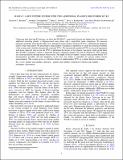WASP-47: A HOT JUPITER SYSTEM WITH TWO ADDITIONAL PLANETS DISCOVERED BY K2
Author(s)
Becker, Juliette C.; Vanderburg, Andrew; Adams, Fred C.; Schwengeler, Hans Martin; Rappaport, Saul A
DownloadBecker-2015-WASP-47_ A HOT JUPIT.pdf (618.8Kb)
PUBLISHER_POLICY
Publisher Policy
Article is made available in accordance with the publisher's policy and may be subject to US copyright law. Please refer to the publisher's site for terms of use.
Terms of use
Metadata
Show full item recordAbstract
Using new data from the K2 mission, we show that WASP-47, a previously known hot Jupiter host, also hosts two additional transiting planets: a Neptune-sized outer planet and a super-Earth inner companion. We measure planetary properties from the K2 light curve and detect transit timing variations (TTVs), confirming the planetary nature of the outer planet. We performed a large number of numerical simulations to study the dynamical stability of the system and to find the theoretically expected TTVs. The theoretically predicted TTVs are in good agreement with those observed, and we use the TTVs to determine the masses of two planets, and place a limit on the third. The WASP-47 planetary system is important because companion planets can both be inferred by TTVs and are also detected directly through transit observations. The depth of the hot Jupiter's transits make ground-based TTV measurements possible, and the brightness of the host star makes it amenable for precise radial velocity measurements. The system serves as a Rosetta Stone for understanding TTVs as a planet detection technique.
Date issued
2015-10Department
Massachusetts Institute of Technology. Department of Physics; MIT Kavli Institute for Astrophysics and Space ResearchJournal
The Astrophysical Journal. Letters
Publisher
IOP Publishing
Citation
Becker, Juliette C., Andrew Vanderburg, Fred C. Adams, Saul A. Rappaport, and Hans Martin Schwengeler. “WASP-47: A HOT JUPITER SYSTEM WITH TWO ADDITIONAL PLANETS DISCOVERED BY K2.” The Astrophysical Journal 812, no. 2 (October 12, 2015): L18. © 2015 IOP Publishing
Version: Final published version
ISSN
2041-8213
2041-8205